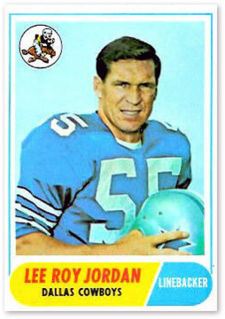Lee Roy Jordan
Lee Roy Jordan (born April 27, 1941 in Excel, Monroe County) is a former professional football linebacker for the Dallas Cowboys from 1963 to 1976 in the National Football League.
University of Alabama
Jordan played collegiately for the University of Alabama from 1960-1962. In his sophomore season of 1960, he helped the Crimson Tide to an 8-2-1 record, finishing the year with a 3-3 tie against University of Texas at Austin in the Bluebonnet Bowl. Jordan was named MVP of the game. The following season, Alabama recorded an 11-0 record and won the national championship. In his final season with the Crimson tide, Jordan was a first team All-American, helped his team to a 10-1 record, and was named the outstanding player of the Orange Bowl when he made 31 tackles en route to a 17-0 victory over the University of Oklahoma. That performance was immortalized in Daniel Moore's painting "Between the Lines".
Jordan's coach in college, Paul "Bear" Bryant once said, "He was one of the finest football players the world has ever seen. If runners stayed between the sidelines, he tackled them. He never had a bad day, he was 100 percent every day in practice and in the games.
The Crimson Tide awards the Lee Roy Jordan Headhunter Award to the top linemen each year.
Dallas Cowboys
Jordan was drafted by the Cowboys in 1963. He became the franchise's all-time leader in solo tackles (743) in his 14 seasons with the Cowboys. He was a two-time All-Pro and a five-time Pro Bowler. He also helped the Cowboys to three Super Bowls and five NFC Championship games.
Jordan was somewhat small for his position at only 6'1" and 215 pounds, but his competitiveness and drive made up for his lack of size. Head coach Tom Landry said of Jordan, "He was a great competitor. He was not big for a middle linebacker, but because of his competitiveness, he was able to play the game and play it well. His leadership was there and he demanded a lot out of the people around him as he did of himself."
He teamed up with Chuck Howley and Dave Edwards, to form one of the greatest linebacking corps in NFL history.
His teammates nicknamed him "Killer". Jordan was team captain for the defense and ran Landry's "Flex" defense on the field with unmatched intensity. He watched game film endlessly, his contract included a projector for his home.
On September 26, 1971, he had a team-record 21 tackles against Philadelphia.
On October 28, 1973, he had 14 solo tackles against Philadelphia, which ranks him tied for third on the club's all-time list.
On November 4, 1973, Jordan intercepted three passes in the first quarter from the Cincinnati Bengals' Ken Anderson within the span of five minutes, returning one 31 yards for a touchdown. The picks were collectively named one of the ten most memorable moments in the history of Texas Stadium by ESPN in 2008.
Not only was Jordan an able defender against the run and pass, he also had a penchant for recovering loose footballs. He remains tied for second in club history with 16 career fumble recoveries.
In his 14 NFL seasons, Jordan intercepted 32 passes (tied for third-most all-time by linebackers), returning them for 472 yards and three touchdowns. He also recovered 18 fumbles, returning them for 37 yards.
More than 25 years after his retirement, Jordan still ranks second in Cowboys' history in career solo tackles with 743, second in career assisted tackles with 493 and second in combined total tackles with 1,236. Jordan still holds the third and fourth highest totals of solo tackles in a single season with 100 in 1975 and 97 in 1968.
Jordan was inducted into the Alabama Sports Hall of Fame in 1980. In 1983, Jordan became a member of the College Football Hall of Fame. In 1989, he became the seventh member of the Dallas Cowboys Ring of Honor at Texas Stadium.
Jordan currently heads the Lee Roy Jordan Lumber Company, headquartered in Dallas.
He now resides in Point Clear, Baldwin County.
References
- Lee Roy Jordan. (2009, October 2). In Wikipedia, The Free Encyclopedia. Retrieved 02:56, November 5, 2009 [1]
